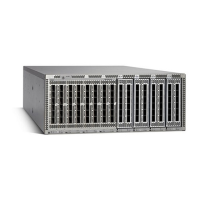Processing Inferior BPDU Information
An inferior BPDU is a BPDU with root information (such as a higher switch ID or higher path cost) that is
inferior to what is currently stored for the port.
If a designated port receives an inferior BPDU, it immediately replies with its own information.
Spanning-Tree Dispute Mechanism
The software checks the consistency of the port role and state in the received BPDUs to detect unidirectional
link failures that could cause bridging loops.
When a designated port detects a conflict, it keeps its role, but reverts to a discarding state because disrupting
connectivity in case of inconsistency is preferable to opening a bridging loop.
The following figure illustrates a unidirectional link failure that typically creates a bridging loop. Switch A
is the root bridge, and its BPDUs are lost on the link leading to Switch B. The 802.1w-standard BPDUs include
the role and state of the sending port. With this information, Switch A can detect that Switch B does not react
to the superior BPDUs it sends and that Switch B is the designated, not root port. As a result, Switch A blocks
(or keeps blocking) its port, which prevents the bridging loop. The block is shown as an STP dispute.
Figure 12: Detecting Unidirectional Link Failure
Port Cost
Rapid PVST+ uses the short (16-bit) path-cost method to calculate the cost by default. With the short
path-cost method, you can assign any value in the range of 1 to 65535. However, you can configure the
switch to use the long (32-bit) path-cost method, which allows you to assign any value in the range of 1
to 200,000,000. You configure the path-cost calculation method globally.
Note
The STP port path-cost default value is determined from the media speed and path-cost calculation method
of a LAN interface. If a loop occurs, STP considers the port cost when selecting a LAN interface to put into
the forwarding state.
Table 6: Default Port Cost
Long Path-Cost Method of Port CostShort Path-Cost Method of Port
Cost
Bandwidth
2,000,00010010 Mbps
Cisco Nexus 6000 Series NX-OS Layer 2 Switching Configuration Guide, Release 7.x
56
Configuring Rapid PVST+
Understanding Rapid PVST+

